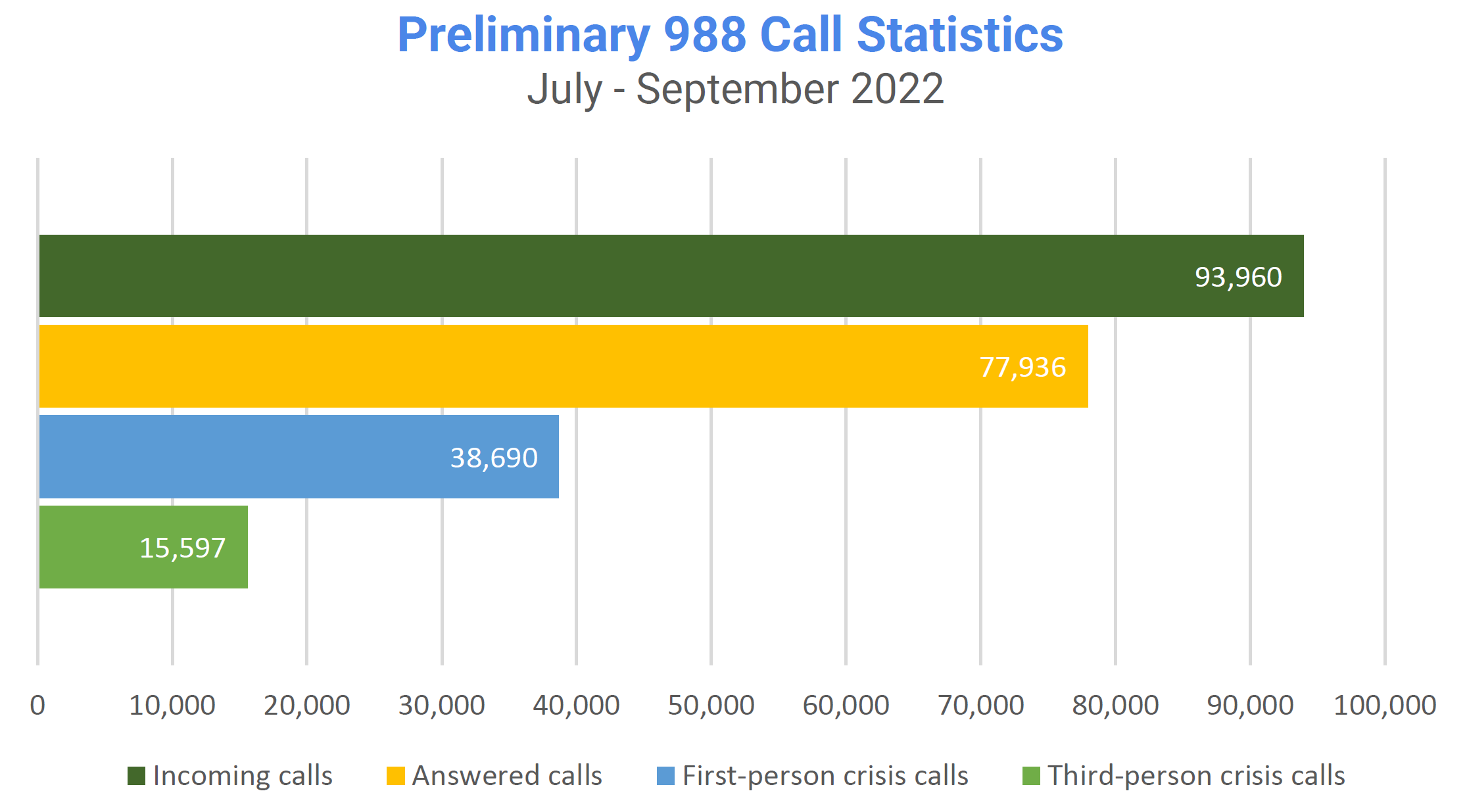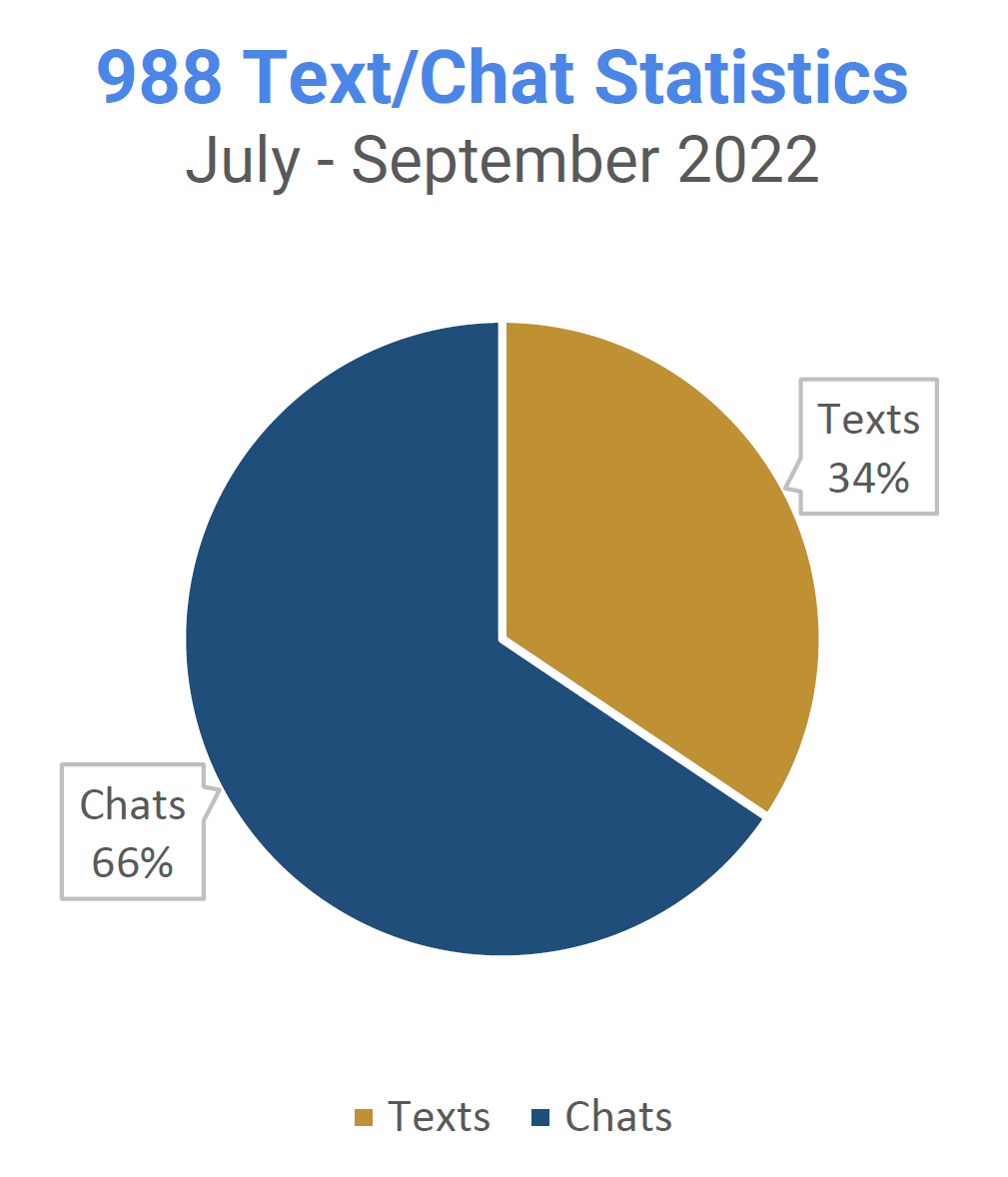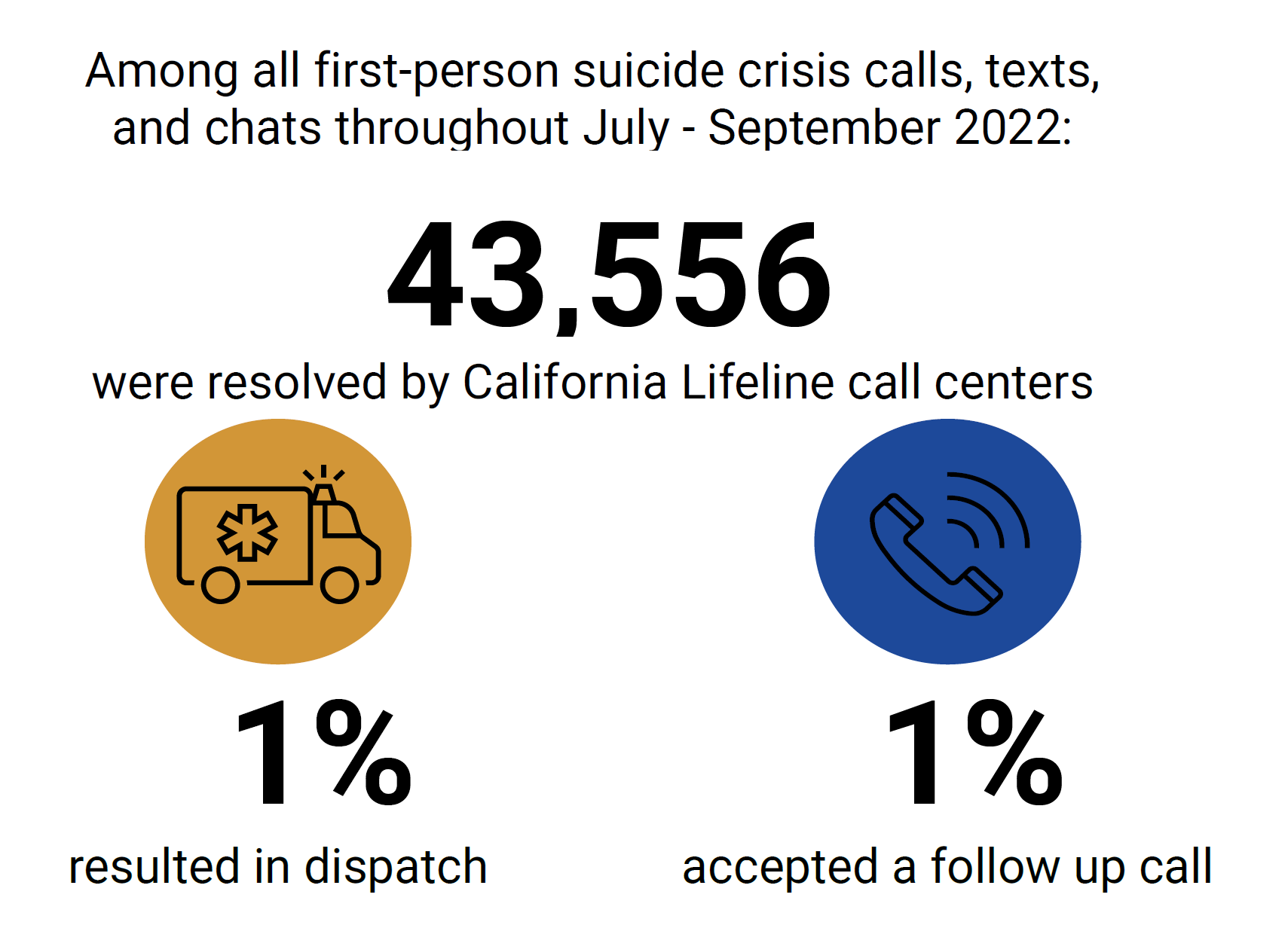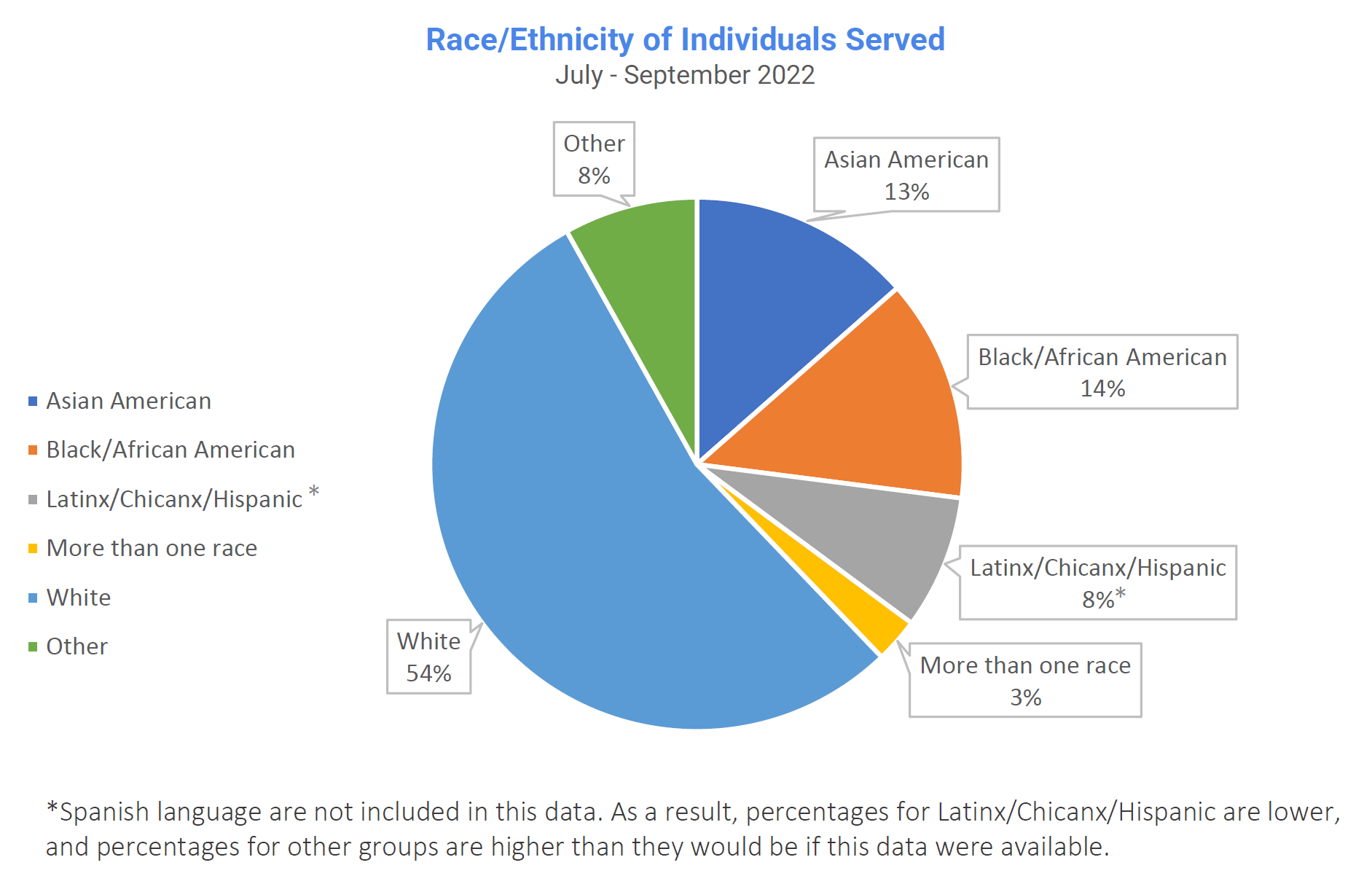THE 988 SUICIDE & CRISIS LIFELINE: DIDI HIRSCH – PRELIMINARY IMPLEMENTATION DATA
Authors: Mackenzie Carroll, Darren Urada, Jailah Johnson, and Dorothy Irrera
The 988 Suicide and Crisis Lifeline
In 2021, with funding from the Coronavirus Response and Relief Supplemental Appropriations Act (CRRSAA) and the American Rescue Plan Act (ARPA), the California Department of Health Care Services (DHCS) developed the Behavioral Health Response and Rescue Project (BHRRP). One key goal of BHRRP is to support the implementation and enhancement of crisis response Lifeline services. On July 16, 2022, 988 became the designated three-digit dialing code that routes callers to the National Suicide and Crisis Lifeline. When individuals call, text, or chat at 988, they are connected to trained mental health counselors who are part of the existing Lifeline network. Didi Hirsch leads a group of California’s 13 Lifeline call centers, supported by 432 call center staff and 650 volunteers.
Call Center Highlights
To better understand the impact of the 988 implementation in California, UCLA Integrated Substance Abuse Programs (ISAP) analyzed data on BHRRP-funded Suicide and Crisis Lifelines from July to September 2022. During this time, California’s 13 Lifeline call centers received 93,960 incoming calls, chats, and texts from 44,094 unique Californians. Overall, call centers answered 83% (77,936) of incoming calls, and the average response time among these calls was 21 seconds. However, if one call center is unable to answer a call, a backup network routes the call to another center in-state. Taking rerouted calls into account, 88% of calls were answered, according to official Lifeline reports. Most calls were first-person crisis calls (i.e., calling during a personal crisis). However, third-person crisis calls (i.e., calling on behalf of someone in crisis) increased to 17% of calls since the launch of 988 in California, compared to 4% in the six months prior.
“In the first few weeks of the 988 launch, California crisis centers experienced a 48% increase in calls. After the initial increase, calls stabilized but remained higher than pre-988 levels.”
- Dr. Stephen Miller, Assistant Program Director at Didi Hirsch


Furthermore, Lifeline call centers have received a 3% increase in chats and texts since 988 became available to the public, compared to reports from January – June 2022 (pre-988). As of September 2022, 7,125 chats have been answered across just three Lifeline call centers, with an average response time of 54 seconds. Similarly, 3,739 texts have been answered across three Lifeline call centers, with an average response time of 121 seconds.
When You Contact 988
When an individual calls 988, they are given the options to connect to the Veterans Crisis Line, access help in Spanish, or remain on the line while the call is routed to a local Lifeline crisis center (based on the caller's area code). If the caller's local crisis center is unable to answer, the call is transferred to another Lifeline crisis center. Once the call is routed, a crisis counselor will answer the phone. They are trained to provide support, share resources, and create a safety plan with the caller. A call is considered "resolved" when the counselor is confident that the caller can keep themselves safe. Connecting the caller to emergency services, such as 911, is a last resort, and most calls are resolved over the phone.
Individuals also have the option to text 988 from their cellphones or chat with a counselor online. Before chatting with a counselor online, individuals are asked to fill out a survey to share more about themselves, their struggles, and feelings, which helps counselors better support individuals from the start of their conversation. Similarly, when individuals text 988, a counselor from a Lifeline crisis center will respond and help in creating a safety plan. No matter how 988 is accessed, the goal is to help individuals in crisis situations by giving them tools and resources to safety (Sherwood, 2022).

Demographics of Individuals Served
Demographic data was difficult for call centers to collect. The race/ethnicity of most individuals served from July to September 2022 was unknown (63%). In addition, 33% of these individuals' genders were unknown. However, among the gender data UCLA did receive, 54% of individuals served identified as women and 45% as men. Data on the race/ethnicity is shown in the graph below. However, when callers press "2" at the start of the call to speak with someone in Spanish, their calls are routed to a separate call center sub-network that is not included in the data reported here. Therefore, the percentage of Latinx/Chicanx/Hispanic callers is reduced to an unknown extent while the percentages for other groups are elevated accordingly.
Over 99% of calls not routed to the Spanish language centers were received in English. A small number of calls (29) were received in Mandarin (22), Cantonese (2), Vietnamese (5), and other languages (5).

Policy Implications
In September 2022, Governor Gavin Newsom signed AB 988, also known as the Miles Hall Lifeline & Suicide Prevention Act. AB 988 provides sustained funding and a long-term implementation plan for California's 988 crisis call centers. Though the signing of AB 988 is an important step in creating more accessible solutions for individuals in need of crisis care, work still needs to be done.
The California Lifeline answered 88% of incoming calls through in-state call centers throughout July – September 2022 and is striving to meet and maintain the National Suicide Prevention Lifeline Standard of 95% of calls answered within 20 seconds and 90% of calls answered within 15 seconds, according to official Lifeline KPI goals.
Only 1% of first- and third-person crisis calls, texts, and chats to 988 resulted in dispatch and an additional 1% in follow up care during July – September 2022. Call center workers are trained to consider dispatch, particularly an "involuntary rescue" including law enforcement, as a last resort. New alternatives are becoming available, however, with the help of funding from DHCS. Approximately 45 counties in California have implemented Crisis Care Mobile Unit (CCMU) services. CCMU services are a community-based intervention designed to provide de-escalation and relief to individuals experiencing a behavioral health crisis, with the intent to reduce unnecessary law enforcement involvement and emergency department utilization (Advocates for Human Potential, 2022). According to Didi Hirsch, there are “varying degrees of capacity” to which California Lifeline call centers can provide follow up calls. However, call centers and CCMU services are working towards integrating these two systems as a part of establishing a crisis continuum of care. From July to September 2022, Lifeline call centers referred 880 first- and third-person suicide crisis callers (about 1% of calls answered) to CCMU services, which suggests positive first steps are being taken to strengthen these collaborations. Doing so could result in a greater percentage of follow up care without incurring the risks associated with police involvement or involuntary hospitalization.
Based on available data, it is difficult to assess whether disparities are occurring. Only 8% of individuals served by Lifeline call centers identified as Latinx/Chicanx/Hispanic compared to the approximately 40% of California’s population that identifies as Hispanic. Comparisons of these two numbers are challenging due to the lack of Spanish Language call data, but for context, 11% of patients in California health care facilities report Spanish as their preferred language (California Department of Health Care Access and Information, 2022). If the same is true of Lifeline callers, this suggests 19% of callers were Spanish speaking and/or Latinx/Chicanx/Hispanic, which is still low relative to California’s Hispanic population. This suggests there may be an opportunity to expand use of the line among Hispanic callers. Hispanic communities often face unique barriers to mental health care (Fripp & Carlson, 2017; Rastogi et al., 2012). Many individuals in these communities face obstacles in receiving mental health care, such as language barriers, cultural competence, legal status, and stigma. Often times, stigma towards mental health conditions within Hispanic communities leads to misinformation. In turn, these communities may not recognize the signs and symptoms of mental health conditions, or where to seek help (National Alliance on Mental Illness, 2022). Therefore, increasing outreach efforts to Hispanic and Spanish-speaking communities, including anti-stigma campaigns, could help this population learn more about mental health services, such as the 988 hotline. Similarly, calls in languages other than Spanish and English also appear to be underrepresented. Where fluent call center staff are not available, recent advancements in readily available real-time speech translation (Sarwar, 2022) may enable some assistance to be delivered.
Additionally, it is important to note that during the July – September 2022 reporting period, there was a large percentage of missing demographic data. Though logistic challenges and privacy concerns might contribute to the difficulty of collecting demographic information during a crisis call, it is vital to increase efforts in collecting this type of information to allow for researchers and policymakers to evaluate 988 outcomes from an equity perspective (Saunders, 2022). If geolocation is added to 988, this would help identify if certain geographic communities are not being reached.
Overall, California’s Lifeline system has successfully expanded services to a broad range of Californians since the launch of 988 on July 16, 2022. When asked about what resources would be helpful to continue making improvements and addressing preliminary issues, Didi Hirsch reported that, "...Additional, sustained funding always makes a difference and would ensure that permanent staffing can be maintained to answer all of the calls, chats, and texts that originate from California." Anecdotally, call centers have had trouble recruiting staff because of the tight labor market, so being able to offer more competitive salaries may help. Though staffing remains a challenge, as well as efforts to address disparities, dispatches, and follow up rates, the preliminary data only captures a small portion of metrics needed to fully understand the implementation of 988 in California. With approximately 4,144 Californians losing their lives to suicide each year (American Foundation for Suicide Prevention, 2022), suicide remains a significant public health challenge. However, the evidence for effective suicide prevention practices grows each day with the help of Didi Hirsch spearheading the implementation of 988 in California.
Note: Figures and calculated percentages presented herein are based off of aggregated data submitted on behalf of the 13 California Crisis Centers by Didi Hirsch. Not all centers reported complete information for every metric, and callers reserve the right to not answer certain questions. Calculations exclude "Unknown" responses.
Recommendations Summary:
- Facilitate greater coordination between the California Lifeline call centers and the Crisis Care Mobile Units (CCMU) program.
- Increase outreach efforts to Hispanic and Spanish-speaking communities.
- Explore ways to increase the capacity to take calls in languages other than English and Spanish.
- Explore ways to improve the collection of demographic data or alternatives, including geolocation.
References
California Department of Health Care Access and Information (2022). Preferred languages spoken in California facilities, from
https://hcai.ca.gov/visualizations/preferred-languages-spoken-in-california-facilities/
California state facts. (2022, April 11). American Foundation for Suicide Prevention. Retrieved December 7, 2022, from https://afsp.org/facts/california/
Fripp, J. A., & Carlson, R. G. (2017). Exploring the influence of attitude and stigma on participation of African American and Latino populations in mental health services. Journal of Multicultural Counseling and Development, 45(2), 80-94. https://doi.org/10.1002/jmcd.12066
Identity and cultural dimensions: Hispanic/Latinx (By National Alliance on Mental Illness). (2022). NAMI. Retrieved December 7, 2022, from https://www.nami.org/Your-Journey/Identity-and-Cultural-Dimensions/Hispanic-Latinx